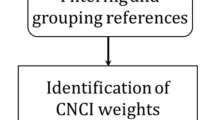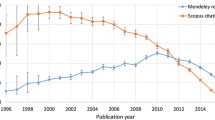Abstract
This study identifies the top individual contributors to 31 LIS journals from 2007 to 2012, both worldwide (all disciplines) and among four groups: LIS faculty in the US and Canada, LIS faculty in the UK, LIS faculty in other countries, and librarians worldwide. The distribution of authorship is highly skewed. Although more than 9,800 authors (86.4 %) each contributed no more than a single article over the six-year period, the top 50 authors (0.4 %) each contributed eight or more articles, with an average of 13.0. Together, the top 50 authors account for nearly 8 % of the LIS literature. Moreover, the most productive LIS faculty are concentrated in relatively few universities. Faculty in the natural sciences and LIS are more likely to be found among the top 50 authors than their overall contributions would suggest, while librarians, computer scientists and non-academic authors are underrepresented. Top authors are especially likely to publish in the Journal of Informetrics and Scientometrics. Among American LIS faculty, the list of the most prolific authors has changed substantially over time. Only three of the top 21 authors of the 1999–2004 period can be found on the current top-20 list.
Similar content being viewed by others
Notes
The US, Canada, and the UK are the three countries with a significant body of literature on this topic—those for which we can draw comparisons with previous research. Note that we use “LIS” in a broad sense when referring to the LIS literature, much of which is written by authors not affiliated with departments of library and information science. We also use it in a narrower sense when referring to faculty who work in LIS departments (those that offer one or more professional credentials for the practice of librarianship).
Table 9 shows only those individuals in departments with CILIP accreditation during the study period. Authors at more recently accredited institutions are not included.
Although Egghe is a professor at Universiteit Hasselt, he served as library director during most of the 2007–2012 period. He is therefore classified as a librarian.
References
Abramo, G., D’Angelo, C. A., & Rosati, F. (2013). Measuring institutional research productivity for the life sciences: The importance of accounting for the order of authors in the byline. Scientometrics, 97(3), 779–795.
Abrizah, A., Zainab, A. N., Kiran, K., & Raj, R. G. (2013). LIS journals scientific impact and subject categorization: A comparison between Web of Science and Scopus. Scientometrics, 94(2), 721–740.
Adkins, D., & Budd, J. M. (2006). Scholarly productivity of US LIS faculty. Library & Information Science Research, 28(3), 374–389.
Adkins, D., & Budd, J. M. (2007). Corrigendum to “Scholarly productivity of US LIS faculty.” Library & Information Science Research, 29(1), 154–158.
Aharony, N. (2012). Library and information science research areas: A content analysis of articles from the top 10 journals, 2007–8. Journal of Librarianship and Information Science, 44(1), 27–35.
Bair, J. H., & Barrons, J. C. (1997). The academic elite in library science: Linkages among top-ranked graduate programs. College & Research Libraries, 58(3), 233–235.
Bates, M. J. (1980). A criterion citation rate for information scientists. Proceedings of the American Society for Information Science Annual Meeting, 17, 276–278.
Bates, M. J. (1998). The role of publication type in the evaluation of LIS programs. Library & Information Science Research, 20(2), 187–198.
Budd, J. M. (2000). Scholarly productivity of US LIS faculty: An update. Library Quarterly, 70(2), 230–245.
Budd, J. M., & Seavey, C. A. (1996). Productivity of US library and information science faculty: The Hayes study revisited. Library Quarterly, 66(1), 1–20.
Cronin, B. (2001). Hyperauthorship: A postmodern perversion or evidence of a structural shift in scholarly communication practices? Journal of the American Society for Information Science and Technology, 52(7), 558–569.
Cronin, B. (2013). Canonicity. Journal of the American Society for Information Science and Technology, 64(11), 2189–2190.
Cronin, B., & Meho, L. I. (2006). Using the h-index to rank influential information scientists. Journal of the American Society for Information Science and Technology, 57(9), 1275–1278.
Cuadra, C. A. (1964). Identifying key contributions to information science. American Documentation, 15(4), 289–295.
Davarpanah, M. R., & Aslekia, S. (2008). A scientometric analysis of international LIS journals: Productivity and characteristics. Scientometrics, 77(1), 21–39.
Davis, P. M. (2014). Articles. http://phil-davis.org/articles/. Accessed 8 December 2014.
Dennis, W. (1955). Variations in productivity among creative workers. Scientific Monthly, 80(4), 277–278.
Ding, Y., & Cronin, B. (2011). Popular and/or prestigious? Measures of scholarly esteem. Information Processing and Management, 47(1), 80–96.
Erfanmanesh, M. A., Didegah, F., & Omidvar, S. (2010). Research productivity and impact of library and information science in the Web of Science. Malaysian Journal of Library & Information Science, 15(3), 85–95.
Finlay, S. C., Ni, C., Tsou, A., & Sugimoto, C. R. (2013). Public or practice? An examination of librarians’ contributions to research. Portal: Libraries and the Academy, 13(4), 403–421.
Frandsen, T. F., & Nicolaisen, J. (2010). What is in a name? Credit assignment practices in different disciplines. Journal of Informetrics, 4(4), 608–617.
Hagen, N. T. (2010). Harmonic publication and citation counting: Sharing authorship credit equitably—not equally, geometrically or arithmetically. Scientometrics, 84(3), 785–793.
Hagen, N. T. (2013). Harmonic coauthor credit: A parsimonious quantification of the byline hierarchy. Journal of Informetrics, 7(4), 784–791.
Hagen, N. T. (2014). Counting and comparing publication output with and without equalizing and inflationary bias. Journal of Informetrics, 8(2), 310–317.
Hawkins, D. T. (2001). Bibliometrics of electronic journals in information science. Information Research, 7(1), paper 120. http://www.informationr.net/ir/7-1/paper120.html. Accessed 8 December 2014.
Hayes, R. M. (1983). Citation statistics as a measure of faculty research productivity. Journal of Education for Librarianship, 23(3), 151–172.
Larivière, V., Sugimoto, C. R., & Cronin, B. (2012). A bibliometric chronicling of library and information science’s first hundred years. Journal of the American Society for Information Science and Technology, 63(5), 997–1016.
Larsen, P. O. (2008). The state of the art in publication counting. Scientometrics, 77(2), 235–251.
Li, J., Sanderson, M., Willett, P., Norris, M., & Oppenheim, C. (2010). Ranking of library and information science researchers: Comparison of data sources for correlating citation data and expert judgments. Journal of Informetrics, 4(4), 554–563.
Lotka, A. J. (1926). The frequency distribution of scientific productivity. Journal of the Washington Academy of Sciences, 16(12), 317–324. http://www.biodiversitylibrary.org/item/123331#page/375. Accessed 8 December 2014.
Manzari, L. (2013). Library and information science journal prestige as assessed by library and information science faculty. Library Quarterly, 83(1), 42–60.
Marchionini, G., Solomon, P., Davis, C., & Russell, T. (2006). Information and library science MPACT: A preliminary analysis. Library & Information Science Research, 28(4), 480–500.
Meho, L. I., & Spurgin, K. M. (2005). Ranking the research productivity of library and information science faculty and schools: An evaluation of data sources and research methods. Journal of the American Society for Information Science and Technology, 56(12), 1314–1331.
Ni, C., Sugimoto, C. R., & Cronin, B. (2013a). Visualizing and comparing four facets of scholarly communication: Producers, artifacts, concepts, and gatekeepers. Scientometrics, 94(3), 1161–1173.
Ni, C., Sugimoto, C. R., & Jiang, J. (2013b). Venue-author coupling: A measure for identifying disciplines through author communities. Journal of the American Society for Information Science and Technology, 64(2), 265–279.
Norris, M., & Oppenheim, C. (2010). Peer review and the h-index: Two studies. Journal of Informetrics, 4(3), 221–232.
Odell, J., & Gabbard, R. (2008). The interdisciplinary influence of library and information science 1996–2004: A journal-to-journal citation analysis. College & Research Libraries, 69(6), 546–564.
Oppenheim, C. (2007). Using the h-index to rank influential British researchers in information science and librarianship. Journal of the American Society for Information Science and Technology, 58(2), 297–301.
Park, T. K. (2008). Asian and Pacific region authorship characteristics in leading library and information science journals. Serials Review, 34(4), 243–251.
Parker, J. N., Allesina, S., & Lortie, C. J. (2013). Characterizing a scientific elite (B): Publication and citation patterns of the most highly cited scientists in environmental science and ecology. Scientometrics, 94(2), 469–480.
Põder, E. (2010). Let’s correct that small mistake. Journal of the American Society for Information Science and Technology, 61(12), 2593–2594.
Price, D. J. (1963). Little science, big science. New York: Columbia University Press.
Price, D. J. (1981). Multiple authorship. Science, 212(4498), 986.
Thomson Reuters. (2012). Journal citation reports: 2011 social science edition. New York: Thomson Reuters.
Salton, G. (1973). On the development of information science. Journal of the American Society for Information Science, 24(3), 218–220.
Sanderson, M. (2008). Revisiting h measured on UK LIS and IR academics. Journal of the American Society for Information Science and Technology, 59(7), 1184–1190.
Schlögl, C., & Petschnig, W. (2005). Library and information science journals: An editor survey. Library Collections, Acquisitions, & Technical Services, 29(1), 4–32.
Schlögl, C., & Stock, W. G. (2008). Practitioners and academics as authors and readers: The case of LIS journals. Journal of Documentation, 64(5), 643–666.
Shaw, D., & Vaughan, L. (2008). Publication and citation patterns among LIS faculty: Profiling a “typical professor.” Library & Information Science Research, 30(1), 47–55.
Stewart, C. (2010). Whither metrics? Tools for assessing publication impact of academic library practitioners. Journal of Academic Librarianship, 36(5), 449–453.
Stewart, C. (2011). Whither metrics, part II. Tools for assessing publication impact of academic library practitioners. Journal of Academic Librarianship, 37(5), 445–448.
Sugimoto, C. R. (2011). Looking across communicative genres: A call for inclusive indicators of interdisciplinarity. Scientometrics, 86(2), 449–461.
Tol, R. S. J. (2011). Credit where credit’s due: Accounting for co-authorship in citation counts. Scientometrics, 89(1), 291–299.
Tuomaala, O., Järvelin, K., & Vakkari, P. (2014). Evolution of library and information science, 1965–2005: Content analysis of journal articles. Journal of the Association for Information Science and Technology, 65(7), 1446–1462.
Varlejs, J., & Dalrymple, P. (1986). Publication output of library and information science faculty. Journal of Education for Library and Information Science, 27(2), 71–89.
Vaughan, L., & Shaw, D. (2008). A new look at evidence of scholarly citation in citation indexes and from web sources. Scientometrics, 74(2), 317–330.
Walters, W. H., & Wilder, E. I. (2015). Disciplinary, national, and departmental contributions to the literature of library and information science, 2007–2012. Journal of the Association for Information Science and Technology, 66 (in press).
White, H. D., & McCain, K. W. (1998). Visualizing a discipline: An author co-citation analysis of information science, 1972–1995. Journal of the American Society for Information Science, 49(4), 327–355.
Wiberley, S. E., Hurd, J. M., & Weller, A. C. (2006). Publication patterns of US academic librarians from 1998 to 2002. College & Research Libraries, 67(3), 205–215.
Yan, E., Ding, Y., & Sugimoto, C. R. (2011). P-Rank: An indicator measuring prestige in heterogeneous scholarly networks. Journal of the American Society for Information Science and Technology, 62(3), 467–477.
Author information
Authors and Affiliations
Corresponding author
Rights and permissions
About this article
Cite this article
Walters, W.H., Wilder, E.I. Worldwide contributors to the literature of library and information science: top authors, 2007–2012. Scientometrics 103, 301–327 (2015). https://doi.org/10.1007/s11192-014-1519-9
Received:
Published:
Issue Date:
DOI: https://doi.org/10.1007/s11192-014-1519-9




